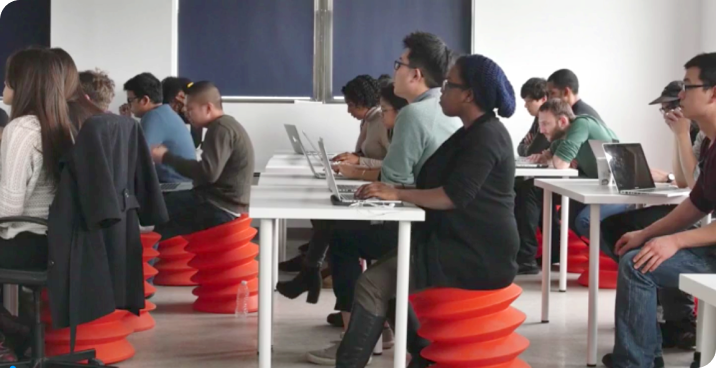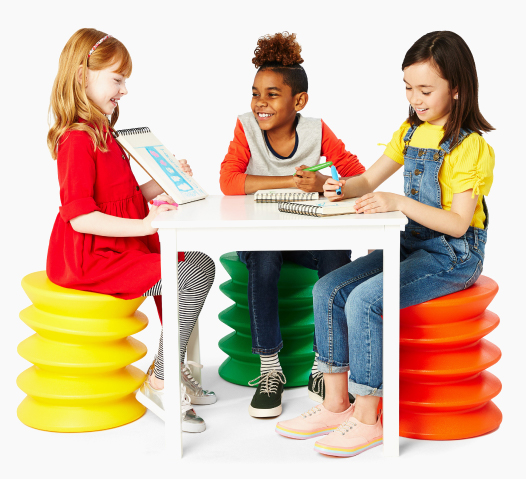ErgoErgo is proud to have received the 2018 Dean’s List Award from Private University Products and News.
KidsErgo is honored to have won Academics Choice MindSpring Award and the Parent Picks Award.

Learning through movement
Concentrate and learn


Students learn better when they can sit actively and “work out the wiggles” to release energy in a healthy way. Moving and stretching address key aspects of UDL (Universal Design for Learning), including enhancing self-regulation through stress reduction, decreasing hyperactivity, and increasing focus.
In a Maryland survey, 84% of educators and occupations therapists reported that sitting on ErgoErgo improved student behavior and that their students would benefit from using ErgoErgo daily.
Active sitting improves learning. Students spend much of each day hunched at desks and computers. In fact, many children today spend more time at computers than playing outdoors, and as many as 30% now suffer from back problems. Schools devote ever-fewer hours to physical education. Childhood obesity is on the rise. More and more young children suffer from backaches and musculoskeletal problems.
Moving and stretching
Work out the wiggles
Dynamic sitting keeps us healthy, alert and productive. The body moves, the mind is stimulated. Babies learn by reaching out, rolling over, crawling. Children play, touch, build. Adults modulate moods, increase learning…through movement.
Mind and body are intimately connected. In fact, we process movement and learning with the same part of the brain. And movement sends oxygen to the brain, resulting in a greater ability to concentrate and learn. Sitting motionless in a rigid chair dulls the mind. Whereas small constant movements engage the vestibular and proprioceptive systems and keep the body — and the mind — alert, aware, awake.


“The most effective dynamic seating”
WHAT THEY’RE SAYING…
Teachers and school OTs report that students sitting on ErgoErgo often show significant improvement in posture, concentration, participation and behavior. Here’s what they’re saying:
- “ErgoErgo is the most effective dynamic seating I’ve used with my students. All students would benefit from it.”
- “Students were able to sit for longer periods of time and fidgeted less. Helps them stay focused, calm, and attentive.”
- “I couldn’t believe the transformation! Now he’s upright, feet on the floor, and unwiggly. And he loves it!”
- “Fidgety student sat properly, with good posture.”
- “Excellent classroom tool for students who struggle with focus. Students more calm and still.”
- “Great for ASD students!”
- “Promoted a more functional sitting position for tabletop fine motor/visual motor activities.”
- “Love, love ErgoErgo chairs! I have several variations of alternate seating in my occupational therapy practice and my students always gravitate toward the Ergo ones. They provide the perfect balance between stability and mobility which enables kids to self-regulate when they are either feeling sluggish or overly active by bouncing or by rocking from side-to-side. The Ergos also promote an upright sitting posture and even encourage kids to hold their writing paper with their non-dominant hand.”
- “Imperative for classrooms!”
- “Better than the ball seat.”
- “Great for core strength, balance, and attention.”
- “Innovative and fun!”
- “I asked my student, ‘Why do you use this?’ He announced joyfully, ‘It helps me do my work!’”
- “I am happy to say that while seated in the Ergo chair we notice a significant improvement in her seated posture. We observed a decrease in the need to prompt the student to sit up, as she is now able to gently rock and bounce to facilitate her trunk/postural muscles. While she continues to require occasional cuing to sit up (to the best of her ability), I have observed less incidences of her flexing her neck forward and looking directly downward. She is now able to tolerate using the Ergo chair as her classroom seating throughout the school day. We are all very pleased with the response that we have seen.”
Learning, thought, creativity, and intelligence are not processes of the brain alone, but of the whole body....And it is our movements that not only express knowledge and facilitate greater cognitive function, they actually grow the brain...Carla Hannaford, Ph.D., Author of “Smart Moves: Why Learning Is Not All in Your Head”
Joyful learning
What can we do? Move!
Small movements are important too. From kindergarten to college, teachers across America report that when students sit actively, for example on exercise balls, misbehavior and sick days decrease. Students pay attention, test better, learn more.
Studies are underway to understand why. Researchers believe that dynamic sitting allows students to maintain an “optimal arousal level” in body and mind to increase concentration.

